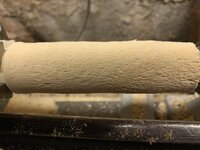JonathanF1968
Member
Here's a photo of an issue that is driving me crazy. Nope, it is not a paint roller. It is maple. In another thread, I mentioned that I had an old maple tree milled for lumber and it is drying out in my basement. I tried turning a few pieces of it today, and I'm getting this dreadful chipping/checking result. While this isn't my most careful work, it was done with a pretty sharp skew. All my tools are producing the same quality. I thought I was losing my mind, and that I somehow forgot how to turn, or was sharpening my tools wrong, etc., but then tried turning a piece of commercially dried cherry and I easily produced a nice, smooth result, which is what I'm used to. (Science....)
So, what the heck. Is the wood too wet? Could it be that I've just been unlucky in choosing pieces that are from a bad part of the log? I've turned green wood before and not had this happen. Is there some quality to spalted maple that makes it prone to this?
I am at a loss here.
So, what the heck. Is the wood too wet? Could it be that I've just been unlucky in choosing pieces that are from a bad part of the log? I've turned green wood before and not had this happen. Is there some quality to spalted maple that makes it prone to this?
I am at a loss here.

